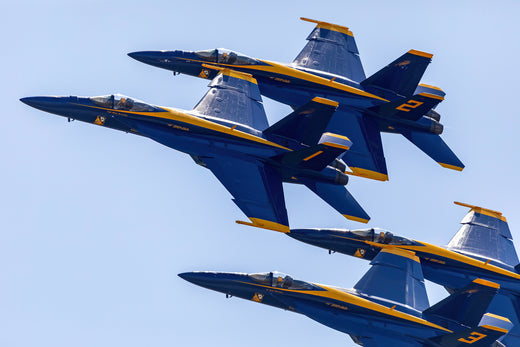This Fine Art Print by Artist Craig Tinder commemorates the legacy of the U.S. Navy Blue Angels.
This is an officially licensed art print of the U.S. Department of the Navy.
 F/A-18 Super Hornet latest and most powerful aircraft of Blue Angel
F/A-18 Super Hornet latest and most powerful aircraft of Blue Angel
In 1946, the United States Navy introduced the Blue Angels, its flight demonstration squadron, to inspire public interest in naval aviation and boost Navy morale. The Grumman F6F Hellcat was chosen as the first aircraft for this elite team. The Hellcat, a formidable fighter during World War II, was renowned for its durability, firepower, and effectiveness in combat.
 The Birth of the Blue Angels: F6F Hellcat (1946-1949)
The Birth of the Blue Angels: F6F Hellcat (1946-1949)
The transition to jet power was a significant milestone for the Blue Angels, marking the dawn of a new era in aviation. In 1949, the team adopted the Grumman F9F Panther, their first jet aircraft. This jet enabled higher speeds and more dynamic maneuvers, allowing the Blue Angels to push the boundaries of what was possible in an aerial performance.
 The First Jet: F9F Panther (1949-1955)
The First Jet: F9F Panther (1949-1955)
Continuing their partnership with Grumman, the Blue Angels transitioned to the F9F Cougar in 1955. The Cougar featured a swept-wing design, offering improved performance and agility compared to its predecessor. This new aircraft allowed the Blue Angels to perform even more impressive aerobatic maneuvers, pushing the envelope of what was possible in the sky.
 Advancing Technology: F9F Cougar (1955-1957)
Advancing Technology: F9F Cougar (1955-1957)
The Grumman F-11 Tiger brought supersonic flight to the Blue Angels, marking another significant leap forward in aviation technology. Introduced in 1957, the Tiger was sleek, fast, and capable of reaching supersonic speeds, showcasing the cutting-edge capabilities of the Navy at the time.
 The Supersonic Era: F-11 Tiger (1957-1969)
The Supersonic Era: F-11 Tiger (1957-1969)
The McDonnell Douglas F-4 Phantom II, a legendary aircraft of the Vietnam War, joined the Blue Angels in 1969. Known for its power and versatility, the Phantom II added a new dimension to the Blue Angels’ shows. This aircraft demonstrated the might of naval aviation during a turbulent time in history, showcasing the era’s technological advancements and combat capabilities.
 Vietnam War Era: F-4 Phantom II (1969-1974)
Vietnam War Era: F-4 Phantom II (1969-1974)
The lightweight and agile Douglas A-4 Skyhawk represented a shift towards smaller, more nimble aircraft. Introduced to the Blue Angels in 1974, the Skyhawk’s agility allowed for tighter formations and more intricate maneuvers, enhancing the visual spectacle of the Blue Angels’ performances.
 Transition to Modern Jets: A-4 Skyhawk (1974-1986)
Transition to Modern Jets: A-4 Skyhawk (1974-1986)
The Story Behind the Print:
Established by Admiral Chester Nimitz 24 April 1946, the Blue Angels were created to raise the public's interest in naval aviation and boost Navy morale. The first aircraft flown in flight exhibitions were the F6F Hellcat and F8F Bearcat, but by 1949 the Navy transitioned to the jet age with the F9F-2 Panther. To celebrate their 75th anniversary in 2021, the Blue Angels unveiled their latest and most powerful aircraft, the F/A-18 Super Hornet.
 The Blue Angels have performed for nearly 500 million spectators worldwide
The Blue Angels have performed for nearly 500 million spectators worldwide
Learn more about A Historical Showcase in Blue Angels Aircraft Evolution, Click Here
To purchase or see similar items, visit here.
Commissioned by Museums, Treasured by Collectors





Share:
American Air Power, the story behind "American Evolution"
Collision Course, the story behind "Final Defense of 357"